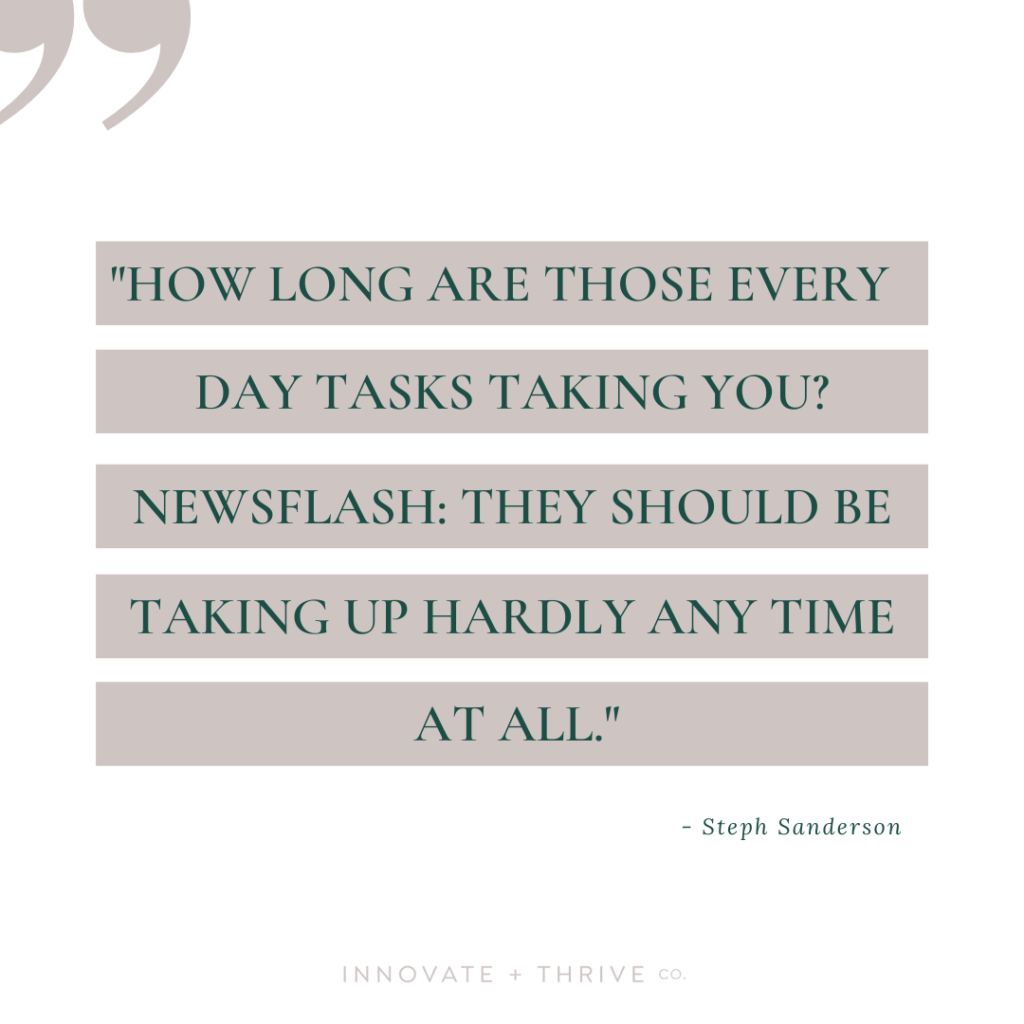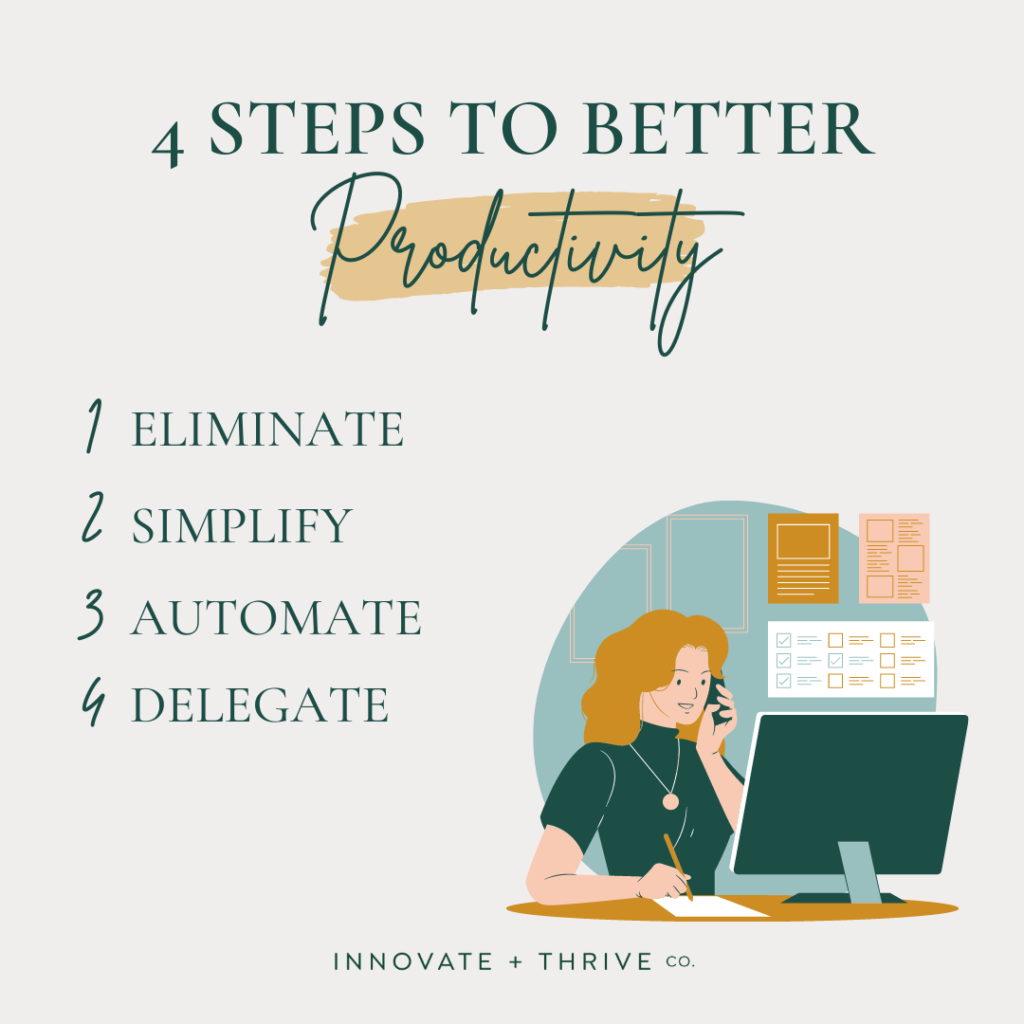

How to be more productive | Business Planning Tips
Getting things done in your business can be a challenge. Find out how to be more productive and profitable. I’ve included proven productivity tips from entrepreneurs and my favourite productivity hacks.
Get more done in less time; that’s the dream, right? Unfortunately, as business owners, simply being more productive isn’t a panacea for success. You need to focus on – and actually achieve – the right things, otherwise you run the risk of being a busy fool. And let’s face it; no one wants that.
Want to know how to be productive? There is no ‘one size fits all’ blueprint for productivity. It’s a personal practice, driven by analysing your current scenario and then simplifying systems, automating processes and delegating tasks.
In this blog, I’ll be sharing my 10-step process on how to be more productive, including:
- Managing your tasks in a way that works for you
- Creating the right work environment
- Setting a routine
- Theme days
- Auditing your business for productivity
- Creating clear processes
- Automation (!!!)
- Saying “NO” to multitasking
- Sense checking your ‘to do’ list
- Categorising tasks
Of course, there’s a lot more that goes into it than ticking tasks off of a list (if only!). Read on for my full guide on how to be more organised and productive as a business owner.
Methods of improving productivity
Productivity hack #1 – Manage your tasks in a way that works for you.
I’m sure we’ve all been there; we try so many different productivity tools on for size that we actually end up staring blankly at the computer screen, begging for your tasks to organise themselves.
It’s an easy trap to fall into, especially when there are so many competing systems on the market. The key is to find a method that works for you and stick with it. Whether that’s a handwritten list, Trello, Asana, Click-Up or whatever feels right, pick your poison and throw yourself into it.
Productivity hack #2 – Create the right working environment.
Especially now, with more people working at home, it’s incredibly important to create a working space that gets you in the right headspace.
This can be as simple as organising your laptop (from your desktop to your folders) or adding small drops of inspiration onto your desk. For me, access to natural light is a necessity, and I love to light a candle and soak up those beautiful scents while working.
Sound is also a great way to encourage a more productive working space. If you’re an extrovert, you could curate a playlist for your working day, whereas if you’re an introvert you may value the silence.
Productivity hack #3 – Set a routine.
Rather than stumbling out of bed and spending half an hour wondering what day of the week it is, start it with a clear idea of what’s in store. You could do this by mapping out your entire week, task by task, in your diary, or writing tomorrow’s actions at the end of the previous day.
While you’re at it, have a think about the distractions in your working day and how you can limit them. Could you only check emails twice a day, or only engage on social media at certain times? Once you’ve decided on a routine, switch off your notifications – even better, keep the device out of eyesight if it isn’t needed.
Productivity hack #4 – Create theme days.
Spend some time looking at your business plan and identifying the different areas of your work – both for working ON and IN your business – and place them into theme days. This areas could include:
- Client calls
- Business admin
- Client work
- Content creation
- Business development
Once you know your areas, time block actions according to themes. Play around with only having client calls on certain days, dedicating one day every week to your own content and business development or separating ‘one off’ and ongoing pieces of work.
You may find that you need to dip your toe into a few different setups. Don’t worry, you’ll find your rhythm.
Productivity hack #5 – Create clear processes and templates.


How long are those everyday tasks taking you? Newsflash: they should be taking up hardly any time at all.
You can create a set of processes and templates for those mundane, repetitive tasks so that you’re not reinventing the wheel (or the email!) every time you open up your desktop. This won’t just save you time; it will also ensure that your communications are consistent, reliable and represent your brand perfectly.
Knowing where to be more productive
Productivity hack #6 – Audit your business for productivity.
Where are you actually spending your time? Is everything you do absolutely necessary? What are the things that keep distracting you?
This one’s an eye-opener! The easiest way to identify your ‘time-wasters’ is through a time and motion study; you can do this using an app such as Now Then Time Tracking. By pinpointing anything surplus, you can get rid of it and streamline anything that’s eating up too much of your time (for very little reward).
Productivity hack #7 – Automate wherever possible.
Yes, it’s the “A” word – my BFF!
Wherever possible, automate. It’s as simple as that. Tasks such as managing client enquiries, onboarding, scheduling appointments and invoicing all take up precious time, when in reality these actions could all be automated.
A system like Dubsado would allow you to do this for $40/month or $400/year. A good deal cheaper than outsourcing! If you want to give it a try, here’s my affiliate link and code: iandtco. It’ll get you 30% of your first invoice (month or year, depending on how you choose to pay).
Productivity hack #8 – Don’t try to multitask.
While you may think that becoming the master of multitasking is the key to a more productive life, the truth is it’s actually slowing you down.
The problem with multitasking is that it tends to result in lower quality work. Keep your mind focused on one task at a time. Remember, there’s only one way to eat an elephant!
Productivity hack #9 – Sense check your list.
So, you’ve got your ‘to do’ list… but, is everything on it really needed?
Look through your list and ask yourself: what would happen if I didn’t do this task? Has it been on my list for over six weeks?
If the answer is ‘absolutely nothing’ and a big old ‘yes!’ then cull my friend, cull.
Productivity hack #10 – Categorise your tasks.
If you find yourself in a super sticky situation and you need to prioritise and work at ultra speed, break your actions down into four categories:
- Urgent and important
- Urgent
- Important
- Other
You can then work through your tasks in that order (and potentially bin off those pesky ones sitting in the ‘other’ pile!). I love the Pomodoro technique for getting stuff done.
Eliminate. Simplify. Automate. Delegate.


Ultimately, business productivity draws down into four core steps.
- Eliminate the work that really doesn’t matter (aka doesn’t give you a worthwhile return!)
- Simplify the tasks that are draining your time and energy
- Automate the everyday activities that pull you away from your actual job
- Delegate tasks or invest in support
Don’t forget – you may be a solopreneur, but you don’t have to tackle the productivity battle on your own.
Business automation tools.
Yes, I’m a huge fan of Dubsado, but there are tons of different business automation tools – to cover the myriad of spaces in your business – that you may want to try, such as:
- Zapier (for joining all the dots and creating automations between your tech and tools)
- ActiveCampaign or Flodesk (for email marketing and CRM – note Flodesk is an affiliate link that get’s you a cheeky 50% off your subscription, forever!)
- Buffer (for social media automation)
- Grammarly (for checking your content)
- Calendly (for booking appointments)
- FreeAgent, Quickbooks or Xero (for managing your invoices)
- GoCardless (for setting up direct debits)
- Bloom, Kitchen or Agiled (CRMs and Dubsado alternatives)
Best project management software.
A reliable, well integrated project management software can be a great way to keep track of tasks, responsibilities and goals; especially when you’re spinning all the plates.
Choosing the best project management software is a personal choice for your business – after all, we all need different things out of it! I’ve recently moved a lot of my projects over to ClickUp and am loving it, but I’d also recommend:
Whatever system you’re looking to introduce, my advice is to always start off with a list of the functions you need; for example, task lists, reporting, communication, file sharing, schedules, appointment scheduling, contract signing … the list goes on. Once you have this to hand, choose the software that ticks all (or most of!) the boxes, and gives you a user experience that you know you’ll work well with.


Steph Sanderson is a business design consultant who helps service-based businesses to accelerate their growth in a sustainable way through pricing, customer experience, process planning, systems and strategic planning. She has over 15 years experience in the field, working as a business manager, global Change Manager and Implementation Specialist. Find out more.
